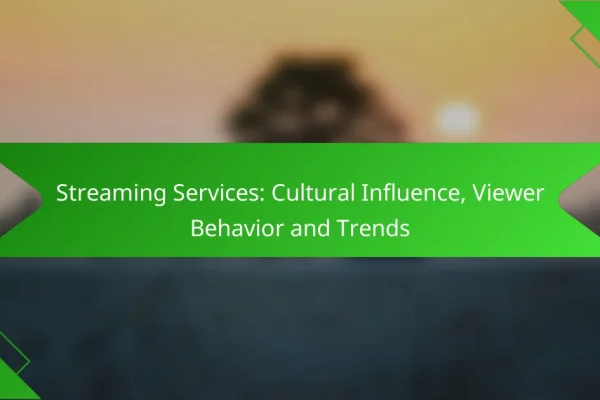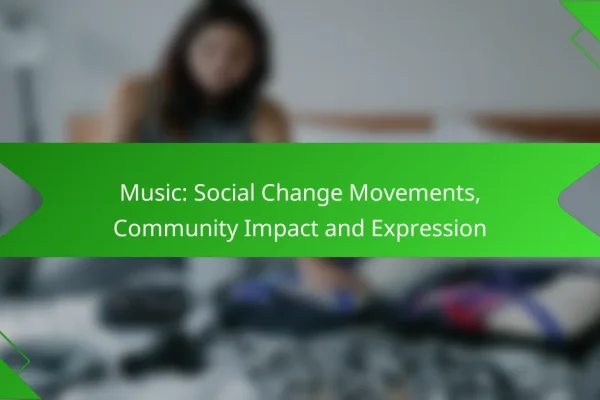What are the current cultural trends in the US?
Current cultural trends in the US reflect significant shifts in work, health, environmental consciousness, social media influence, and inclusivity. These trends are shaping how individuals and communities interact, prioritize their well-being, and engage with one another.
Rise of remote work culture
The rise of remote work culture has transformed the traditional workplace in the US. Many companies have adopted flexible work arrangements, allowing employees to work from home or other locations, which has led to increased job satisfaction and productivity for some.
However, this shift also presents challenges, such as maintaining team cohesion and managing work-life balance. Employers should consider implementing regular check-ins and virtual team-building activities to foster connection among remote workers.
Increased focus on mental health awareness
There is a growing emphasis on mental health awareness across various sectors in the US. This trend is characterized by increased discussions around mental health issues, reduced stigma, and the integration of mental health resources in workplaces and schools.
Organizations are encouraged to provide mental health support, such as counseling services and wellness programs, to promote employee well-being. Individuals are also urged to prioritize self-care and seek help when needed, recognizing that mental health is as crucial as physical health.
Growth of sustainability movements
Sustainability movements are gaining momentum in the US, driven by concerns over climate change and environmental degradation. Communities are increasingly advocating for eco-friendly practices, such as reducing waste, conserving energy, and supporting local businesses.
Individuals can contribute by adopting sustainable habits, such as recycling, using public transportation, and choosing products with minimal packaging. Participating in local sustainability initiatives can also foster a sense of community and shared responsibility.
Influence of social media on youth
Social media significantly influences youth culture in the US, shaping trends, communication styles, and self-identity. Platforms like Instagram, TikTok, and Snapchat are pivotal in how young people express themselves and connect with peers.
While social media can foster creativity and community, it can also lead to issues such as cyberbullying and unrealistic comparisons. Parents and educators should engage in open conversations with youth about responsible social media use and its impact on mental health.
Diversity and inclusion initiatives
Diversity and inclusion initiatives are increasingly prioritized by organizations in the US, aiming to create equitable environments for all individuals. These efforts focus on promoting representation across various demographics, including race, gender, and sexual orientation.
Companies are encouraged to implement training programs, diverse hiring practices, and inclusive policies to foster a culture of belonging. Engaging employees in these initiatives can enhance workplace morale and drive innovation through diverse perspectives.
How are cultural trends shaping consumer behavior?
Cultural trends significantly influence consumer behavior by shifting preferences towards sustainability, local products, and digital marketing strategies. As consumers become more aware of social and environmental issues, their purchasing decisions increasingly reflect these values.
Shift towards eco-friendly products
The demand for eco-friendly products has surged as consumers prioritize sustainability. Many shoppers now actively seek items that are biodegradable, recyclable, or made from renewable resources. Brands that emphasize their commitment to environmental responsibility often see increased loyalty and sales.
For example, companies offering organic food, sustainable fashion, and green household products are gaining traction. Consumers are willing to pay a premium for products that align with their values, often spending around 10-20% more on eco-friendly options.
Preference for local brands
There is a growing preference for local brands as consumers aim to support their communities and reduce their carbon footprint. Buying local not only fosters economic growth but also enhances the perceived quality and authenticity of products.
Many consumers are drawn to farmers’ markets, local artisans, and regional manufacturers. This trend encourages brands to highlight their local roots and engage with their communities, which can lead to stronger customer relationships and brand loyalty.
Impact of influencer marketing
Influencer marketing has transformed how brands connect with consumers, leveraging social media personalities to promote products. Influencers often have dedicated followings that trust their recommendations, making them effective in shaping consumer opinions and behaviors.
Brands collaborating with influencers can reach targeted demographics more efficiently. However, it’s crucial for companies to choose influencers whose values align with their brand to maintain authenticity and avoid backlash. Successful campaigns often see engagement rates significantly higher than traditional advertising methods.
What role does technology play in cultural trends?
Technology significantly influences cultural trends in the US by shaping how people consume content and interact with each other. Innovations in digital platforms and devices have transformed entertainment, communication, and social engagement, driving new cultural phenomena.
Adoption of streaming services
The rise of streaming services has revolutionized how Americans access and enjoy media. Platforms like Netflix, Hulu, and Disney+ have shifted viewing habits from traditional cable to on-demand content, allowing users to binge-watch entire seasons at their convenience.
This shift has led to a diversification of content, with niche genres gaining popularity and more voices being represented. As a result, streaming services have become key players in shaping cultural narratives and trends.
Virtual reality experiences
Virtual reality (VR) is emerging as a unique medium for cultural engagement, offering immersive experiences that traditional media cannot match. VR allows users to step into different worlds, whether for gaming, education, or virtual tourism, enhancing their connection to various cultural contexts.
As VR technology becomes more accessible, its role in cultural trends is likely to expand. Brands and creators are exploring VR for storytelling, creating interactive experiences that resonate with audiences in innovative ways.
Social media platforms driving trends
Social media platforms like Instagram, TikTok, and Twitter are pivotal in shaping cultural trends by enabling rapid dissemination of ideas and content. These platforms facilitate the sharing of memes, challenges, and viral content, often reflecting and amplifying current cultural conversations.
Users can quickly engage with trends, making social media a powerful tool for influencers and brands to connect with audiences. Understanding the dynamics of these platforms is essential for anyone looking to navigate or leverage cultural trends effectively.
How do cultural trends vary across different regions in the US?
Cultural trends in the US differ significantly by region, influenced by factors such as geography, history, and demographics. These variations manifest in lifestyle choices, social movements, and local customs, shaping the identity of communities across the country.
Urban vs rural cultural differences
Urban areas tend to embrace diverse cultural influences, resulting in vibrant arts scenes, varied entertainment options, and progressive social attitudes. In contrast, rural regions often prioritize traditional values, community ties, and local customs, leading to a more homogeneous cultural experience.
For example, cities like New York and Los Angeles showcase a mix of global cuisines and modern fashion trends, while rural towns may focus on local agriculture and craftsmanship. This divergence affects everything from social interactions to lifestyle choices.
Regional food and fashion trends
Food and fashion trends vary widely across the US, reflecting local ingredients and cultural heritage. In the South, comfort foods like fried chicken and biscuits dominate, whereas the Pacific Northwest emphasizes fresh, organic produce and seafood.
Fashion also differs; urban centers may favor high-end, designer labels, while rural areas often lean towards practicality and comfort. Seasonal changes can further influence these trends, with warmer climates promoting lighter fabrics and styles.
Variations in social movements
Social movements in the US are often region-specific, shaped by local issues and cultural contexts. For instance, coastal cities may lead in environmental activism, while the Midwest might focus on agricultural policies and labor rights.
These movements can gain momentum through regional networks, with grassroots organizations addressing community-specific concerns. Understanding these variations is crucial for effective advocacy and engagement in social issues across the country.
What are the implications of cultural trends for businesses?
Cultural trends significantly influence consumer behavior, impacting how businesses market their products and services. Understanding these trends allows companies to align their strategies with evolving societal values and preferences, leading to better engagement and sales.
Need for adaptive marketing strategies
Adaptive marketing strategies are essential for businesses to stay relevant in a rapidly changing cultural landscape. Companies must continuously analyze consumer preferences and adjust their messaging, channels, and offerings accordingly.
For instance, brands that embrace sustainability and social responsibility often resonate more with younger consumers. Businesses should consider incorporating eco-friendly practices or promoting diversity in their marketing to reflect current cultural values.
To effectively adapt, companies can utilize data analytics to track shifts in consumer sentiment and behavior. Regularly updating marketing campaigns based on these insights can prevent misalignment with cultural trends and enhance brand loyalty.











